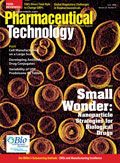In the Spotlight June 2008
Editors' Picks of Pharmaceutical Science & Technology Innovations
Editors' Picks of Pharmaceutical Science & Technology Innovations
The pharmaceutical manufacturing line transforms research into reality, but it takes the right kind of equipment and technology to turn ingredients into dosage forms. With recent advances in material-handling equipment and automation devices, laboratory and manufacturing technicians can be more confident about their processes and end products. This month's highlighted products all play a role in making manufacturing more efficient.

uprox1 proximity sensors (Turck)
Encapsulator handles highly potent products
The "Isolated IN-CAP" capsule-filling system from Schaefer Technologies (Indianapolis, IN) and Dott. Bonapace (Milan) is designed for containing highly potent products. The IN-CAP encapsulator is enclosed in an isolator specially designed by Schaefer. Operators access the unit through ergonomically designed gloveports. Nathan Lawrence, project engineer at Schaefer, says the machine's gloveports have electronically monitored safety covers. If an operator opens a safety cover when the encapsulator is running, the unit will stop.

Isolated IN-CAP encapsulator (Schaefer Technologies)
The unit's dynamic airlock is protected by a high-efficiency particulate air (HEPA) filter and maintains operator exposure at the nanogram level.
The encapsulator incorporates a closed air system and does not require external venting. Screens protect the HEPA filters on the exhaust and inlet sides of the unit during operation. The HEPA filters keep the fan and plenums out of the contaminated area, Lawrence adds.
Factor-1 sensors withstand washdown environments
The Factor-1 "uprox+" proximity sensors from Turck (Minneapolis, MN) sense all metals at the same range. The devices are available with sensing ranges as high as 30 mm and barrel sizes from 12 to 30 mm.
The units are appropriate for washdown processes in the pharmaceutical industry. The sensors' cap is made of a liquid-crystal polymer that resists harsh chemicals. Double sealing protects the sensors against moisture ingress. The units' stainless steel construction resists continuous pressures of 145 psi. In addition, the sensors withstand temperatures from-40 to 100 °C.
Compact conveyor saves energy
The "C2100-64" conveyor from PIAB (Täby, Sweden) is designed for areas with low headroom. The machine's overall height is about 11.5 in. Even when space above a tablet press is limited, users can slide the conveyor above it, according to Vincent Thomas, PIAB's industry manager for the pharmaceutical and chemical industries.

C2100-64 conveyor (PIAB)
The conveyor features "COAX" multistage ejector technology, which allows the unit to consume less air and energy than pneumatically driven vacuum conveyors. The conveyor operates with feed pressures of 58–87 psi and working temperatures of 0–140 °F. Thomas says the conveyor is designed for low flow rates (around 1200 lb/h).
The device is assembled with triclover-style band clamps. It can be quickly disassembled, cleaned, and reassembled in less than 20 min without tools, Thomas says. A 0.5-μm filter prevents powder from entering the vacuum pump.
New Product Announcements may be sent to New Products Editor, Pharmaceutical Technology, 485 Route One South, Building F, First Floor, Iselin, NJ 08830, fax 732.596.0005, ptpress@advanstar.com

Drug Solutions Podcast: A Closer Look at mRNA in Oncology and Vaccines
April 30th 2024In this episode fo the Drug Solutions Podcast, etherna’s vice-president of Technology and Innovation, Stefaan De Koker, discusses the merits and challenges of using mRNA as the foundation for therapeutics in oncology as well as for vaccines.
Entering New Domains for 3D Printing of Drug Products
April 6th 20253D printing of personalized medications is currently possible under existing compounding regulations, offering enhanced process control through automation. But new legislation coming in 2025 will allow 3D printing as part of a distributed manufacturing framework.